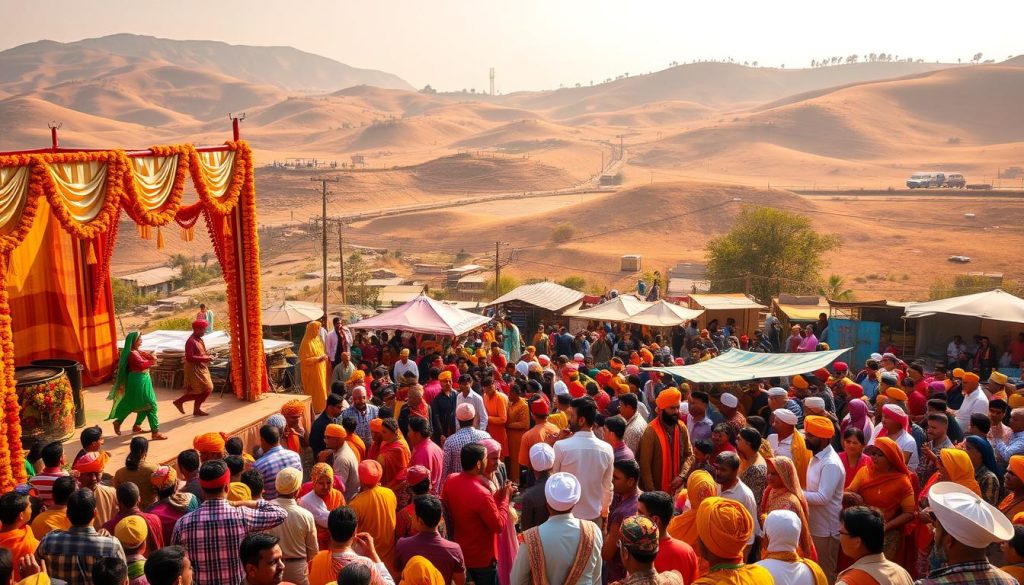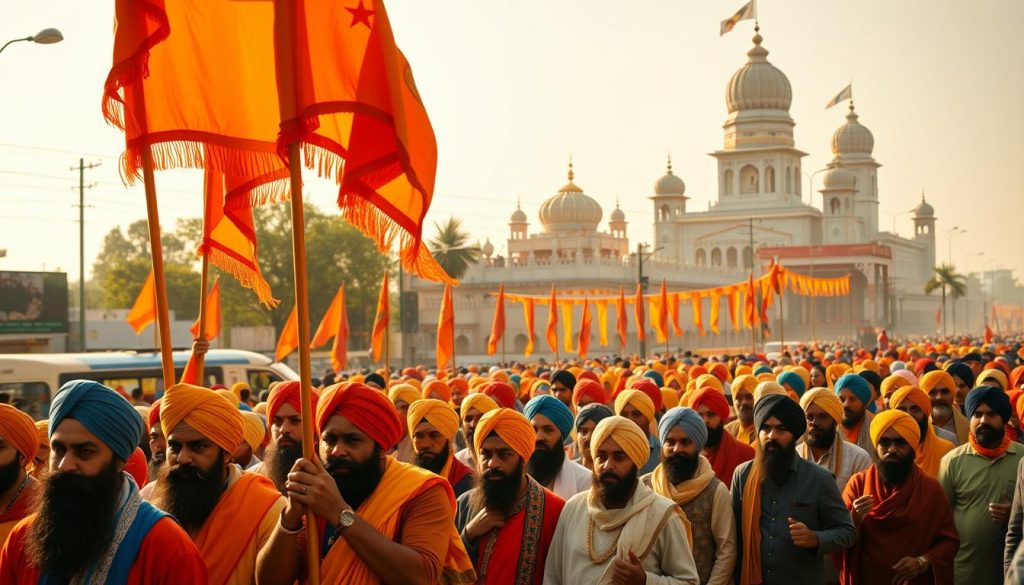What is the Speciality of Baisakhi? Baisakhi, or Vaisakhi, is a festival celebrated in April. It falls on April 13 or 14 each year. In 2024, it’s set for Saturday, April 13. This marks the first day of the Vaisakh month in the Hindu calendar. It is a blend of harvest joy and spiritual milestones.
For Sikhs, it honors the 1699 founding of the Khalsa. While Hindus view it as the solar new year.
What is the significance of Baisakhi? It bridges agriculture and faith. Farmers in Punjab celebrate the wheat harvest. Sikhs revere the day Guru Gobind Singh baptized the first Panj Piare.
Fairs, temple prayers, and bhangra dances erupt across northern India. It makes it a vibrant cultural anchor. From the Ganges-bathing pilgrims in Haridwar to Punjab’s Nagar Kirtan parades, Baisakhi is a tapestry of traditions.
Key Takeaways
- Baisakhi is celebrated in April, specifically on April 13 or 14 annually.
- It’s a harvest festival and the solar new year in regions like Punjab and Haryana.
- Sikhs commemorate the 1699 creation of the Khalsa order during Baisakhi.
- Over 5 million pilgrims attend Haridwar’s Kumbh Mela during the festival.
- It unites faith and tradition, with rituals ranging from temple ceremonies to home whitewashing in Himachal Pradesh.
The Historical Significance of Baisakhi
Baisakhi’s history is deeply rooted in agriculture and religion. For Punjabi communities, it celebrates the end of harvest and the founding of Khalsa Panth. This dual purpose has shaped its legacy.
The Birth of the Khalsa: Baisakhi’s Spiritual Foundation
In 1699, Guru Gobind Singh made Baisakhi a key moment in Sikh history. At Anandpur Sahib, he asked for volunteers to join the Khalsa. Five brave followers, the panj piare, stepped forward.
This act created Amrit Chakhna, a key rite for Sikhs. It turned Baisakhi into a symbol of unity and faith.
Agricultural Roots: Baisakhi as a Harvest Celebration
Before 1699, Baisakhi honored Punjab’s farmers. It celebrated the end of wheat harvest. Families thanked Indra, the rain god, with feasts and dances.
This tradition is still important in why we celebrate baisakhi in punjabi villages today.
The Evolution of Baisakhi Through Centuries
Baisakhi’s journey shows Punjab’s struggles and victories. In 1801, Maharaja Ranjit Singh used it to unite Sikhs politically. The 1919 Jallianwala Bagh massacre during Baisakhi protests made it a symbol of resistance.
Unlike Lohri (celebrated in January), Baisakhi now combines harvest joy with Sikh heritage. It brings Sikhs together worldwide.
What Is the Speciality of Baisakhi in Indian Culture

Baisakhi is special in Indian culture because it’s both a harvest festival and a religious milestone. It starts the spring harvest and the solar new year. This makes it a time of thanks for the harvest and spiritual renewal.
- Cultural Unity: Baisakhi is important in India because Sikhs celebrate its founding of the Khalsa in 1699. Punjabi Hindus see it as a harvest festival.
- National Links: Festivals like Puthandu (Tamil Nadu) and Bohag Bihu (Assam) also celebrate the solar new year. They show India’s diverse yet connected traditions.
- Global Reach: In the U.S., a 2022 resolution made April 14 National Sikh Day. This honors Sikh contributions and promotes inclusivity.
In India, Baisakhi is celebrated with lively Nagar kirtans and free langar meals. These activities bring people together. The five K’s—kes, kara, kanga, kachera, and kirpan—show Sikh values. People wear these symbols during celebrations.
Traditional Baisakhi Celebrations and Customs

Baisakhi comes alive with rituals, music, and color. These traditions connect the past to the present. They unite people all over the world.
Gurdwara Visits and Religious Ceremonies
At dawn, Sikhs meet in Gurdwaras filled with flowers and lights. The Nagar Kirtan processions carry the Guru Granth Sahib on palanquins. They are followed by hymns and drumbeats.
The amrit sanchar ceremony welcomes new Khalsa members. Langar meals feed thousands, showing equality. In Anandpur Sahib, people sing Waheiguru together.
Bhangra and Gidda: The Iconic Dances of Baisakhi
Fields come alive with bhangra’s rhythms and gidda’s gestures. Men dance in turbans, women in phulkari saris. Dhol beats bring everyone together.
These traditions also reach U.S. cities like New York. Punjabi communities hold dance competitions.
Festive Foods and Culinary Traditions
- Karah prasad (sugar-laden semolina) symbolizes community.
- Tables are full of makki di roti and sarson da saag, celebrating harvests.
- At Delhi’s Banglaa Sahib Gurdwara, volunteers make langar for thousands, showing service.
Colorful Attire and Decorations
Women wear kurtas and dupattas in saffron and gold. Men tie turbans with care. Homes shine after prau lagana (white-washing), symbolizing renewal.
Nagar Kirtan floats have flower-bedecked chariots. Nishan Sahib flags fly at Gurdwaras. In Jammu, Dogra Bhangra dances under paper-lantern arches complete the scene.
Conclusion: The Enduring Spirit of Baisakhi in Modern Times
The significance of Baisakhi is in its blend of faith, culture, and community. The vaisakhi festival on April 13, 2024, is a celebration of Punjab’s heritage. It marks the founding of the Khalsa in 1699 and the harvest season.
Modern celebrations like Nagar Kirtan in cities worldwide keep Baisakhi alive. These events mix old traditions with new joy. They show how Baisakhi connects past and present.
Today, baisakhi celebration brings people together across the globe. In the U.S., cities like New York and Houston host digital and traditional events. Farmers in Punjab still offer their first crops to gurdwaras, showing respect for tradition and sustainability.
Baisakhi’s legacy is seen in Bhangra beats and karha prashad. It’s not just about rituals; it’s a bridge between past and present. Joining a Nagar Kirtan or enjoying makke di roti connects us all. It reminds us of the importance of unity and joy.
FAQ
What is the speciality of Baisakhi?
Baisakhi is a lively festival in Punjab and India. It welcomes the solar new year and celebrates the wheat harvest. It’s also a key moment in Sikh history, marking the start of the Khalsa in 1699.
What is the significance of Baisakhi?
Baisakhi is special because it celebrates two important things. It thanks the harvest and honors the Khalsa’s founding. This is a big deal for Sikh identity and community.
In which month is Baisakhi celebrated?
Baisakhi happens in April, on the 13th or 14th day.
Which god is worshipped on Baisakhi?
Many gods are honored on Baisakhi, especially those linked to farming. But Sikhs mainly focus on Guru Gobind Singh. They hold rituals and ceremonies to remember him.
What is the difference between Lohri and Baisakhi?
Lohri is in January and ends winter. Baisakhi, in April, celebrates the harvest. Both are about Punjabi culture but focus on different times of the year.
Why is Baisakhi important in Punjab?
Baisakhi is crucial in Punjab because it’s the peak wheat harvest time. It’s also a big cultural event that strengthens Sikh identity and community spirit.
What is the purpose of Baisakhi?
Baisakhi is to celebrate the harvest and thank for the abundance. It also marks the birth of the Khalsa, showing Sikh spiritual and cultural identity.
What is the significance of Baisakhi in India?
In India, Baisakhi is a celebration of spring harvest and spiritual renewal. It shows values of community, gratitude, and identity, important beyond Punjab.
Why do we celebrate Baisakhi in Punjabi?
Baisakhi is celebrated in Punjabi culture to honor farming, Sikh heritage, and community ties. It shows the region’s rich harvest and cultural and spiritual values. For more insights on festivals and traditions, visit What is the Specialty Of.
